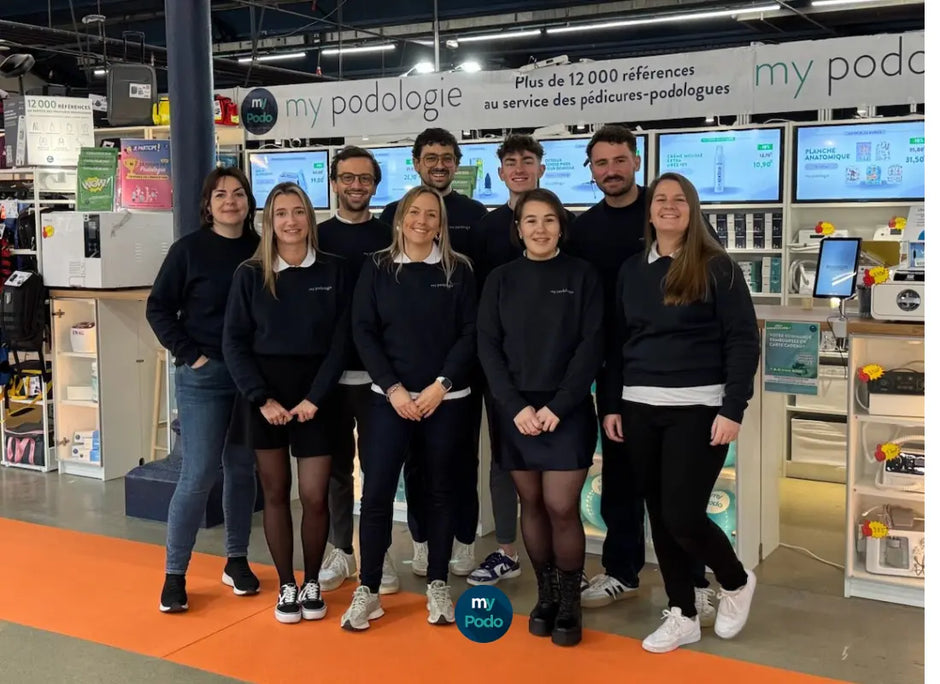In all podiatry practices, we use hand hygiene. It is mandatory and does not stop at health professionals. It affects the entire population, especially in these difficult times that we are all experiencing.
Hand hygiene is used to prevent and avoid the cross-transmission of microorganisms between several individuals. It must be properly practiced to minimize the risks of infections associated with care in offices, or to limit the risk of nosocomial infections that can be transmitted in hospitals.
My Podologie has decided to remind you about this concept of hand hygiene by showing you the steps of a classic hand wash at home or in the office. There are three types of hand hygiene: hand washing with mild liquid soap, hydroalcoholic friction and surgical hand disinfection.
Washing with mild liquid soap
This is the best known and oldest hand washing technique. We often use it, at home, at work, in various public places. The major role of hand washing with mild liquid soap is to eliminate organic dirt on the individual's hands by mechanical and detergent action by reducing the transient flora (bacterial flora that is exchanged between patient/practitioner).
For optimal action, this hand hygiene technique must be carried out under certain conditions. It is advisable to have short nails without varnish, not to wear bracelets, watches or jewelry (rings, wedding rings) and to have short-sleeved work clothes.
There are times during the day when hand washing is mandatory: arrival at the office, after going to the toilet, before/after meals and when an individual's hands have visible macro-soiling (individual suspected or affected by parasites transmitted by contact "Scabies"). For this technique to be carried out properly, there is a certain routine of step-by-step gestures, which the individual must master so that hand washing with mild soap is as optimal as possible.
Here are the steps presented in video:
At My Podologie, we offer several quality liquid mild soaps (click on the image to go to the "SOAP" category):
- The Aniosafe Gentle Soap range by Anios Laboratories
- The Alkadoux range offered by Alkapharm
- The Aleppo Soap range offered by Alépia
- The Traditional Marseille Soap range offered by Le Comptoir du Bain
Hydro-Alcoholic Friction
These are products that exist in the form of gels or solutions that contain disinfecting agents "alcohol", agents that protect the skin from irritations "emollient agents", thickening agents and water. They do not contain dyes or perfumes.
It is a simple, quick, easily reproducible hand hygiene technique that is more effective than hand washing in treating various common microorganisms such as bacteria, viruses, yeasts, molds and mycobacteria. On the other hand, unlike washing with soap, it will not be effective on contact parasites or other resistant microorganisms. But it remains a technique that is better tolerated by the skin than washing hands with soap. After simple hand disinfection, do not rinse or dry your hands. You should know that water reactivates certain bacteria or viruses made inactive by a hydroalcoholic gel, such as COVID19.
In the office and in all healthcare facilities, it is the reference technique in terms of hand hygiene. We use hydroalcoholic friction in the event of: changing gloves, at the start or end of a shift, after any contact with a patient in septic isolation, before performing an invasive procedure (peripheral catheter, urinary catheter and other devices of the same type), after contact with an infected patient or with their environment, between two patients, after any potentially contaminating procedure, in the event of a succession of contaminating procedures for the same patient, before any contact with a patient in protective isolation and many other more complex situations.
To use this technique during a day in the office, you should know that the prerequisites are the same as for washing hands with soap (short nails, clean and dry hands, etc.), but the indications are different, because this technique will be mandatory in all situations that involve care in general.
Just like washing with soap, the individual must perform very specific actions and follow a few steps to ensure the quality of hand disinfection.
Here is a little reminder in pictures of all the steps that must be followed (whether for washing with soap or hydro-alcoholic solution):

At My Podologie, we offer several quality hydroalcoholic gels and solutions (click on the images to go to the product sheet):
- The Aniosgel range offered by Anios Laboratories which includes Aniosgel 85 NPC (30ml, 75ml, 100ml, 300ml, 500ml and 1L)
- The Alkafresh range offered by Alkapharm (100ml, 300ml, 500ml and 1L)
- The Exeol range offered by Sodel which includes Exeol Gel 82 (100ml, 300ml, 500ml and 1L)
Surgical hand disinfection
This hand hygiene technique is a bit special because it will be used before any surgical, obstetrical and interventional radiology procedure. But also before any procedure for which surgical asepsis is required: placement of a central catheter, spinal catheter, implantable chamber, amniotic puncture, pleural drain and other similar situations. The prerequisites and indications are the same as for hand disinfection by friction. What will change are the steps and processes which will obviously be stricter.
1. Take a surgical brush, wet it and add a dose of mild liquid soap
2. Rinse your hands, forearms, elbows
3. Take enough soap to soap up to your elbows.
4. Brush your nails with the surgical brush
5. Rinse and pat hands dry (1 minute)
6. Perform a hydroalcoholic friction up to the elbows (45 seconds)
7. Perform a hydroalcoholic rub up to the wrists (45 seconds)









